Top 10 Best Wood Fillers for Perfect Finishing
- April 5, 2024
- 0 comment
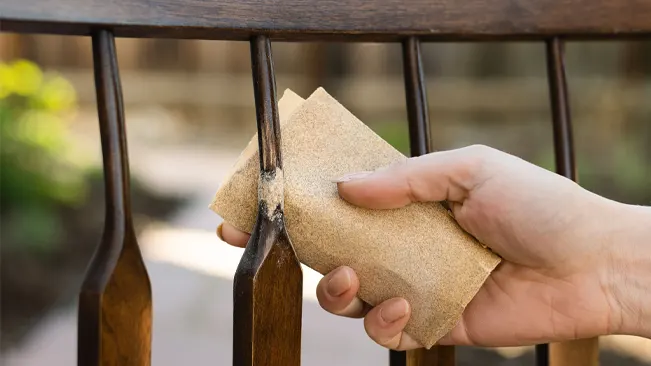
For every woodworker, the choice of wood filler is as essential as selecting the right lumber or finish, as it plays a pivotal role in achieving a flawless final product. Wood fillers are the hidden gem in woodworking, seamlessly blending with the wood to repair cracks, holes, or imperfections, thereby allowing for a pristine, smooth finish.
Understanding the different types of wood fillers, their compatibility with stains and paints, and their suitability for either indoor or outdoor use is key to perfecting your woodworking projects.
This guide aims to provide essential insights into selecting the best wood fillers, ensuring that your craftsmanship is not only visually appealing but also enduring.
List of 10 Best Wood Fillers
- Elmer’s Carpenter’s Wood Filler – Easy indoor repairs.
- Goodfilla Wood & Grain Filler – Eco-friendly versatility.
- Minwax Stainable Wood Filler – Excellent stainability.
- DAP All Purpose Wood Filler – Fast-drying versatility.
- Elmer’s E892 – Outdoor resilience.
- Ronseal High-Performance Wood Filler – Excellent for durability.
- Bondo Wood Filler – Great for larger repairs.
- FamoWood 40022126 Latex Wood Filler – Easy to sand and paint.
- Aqua Coat Wood Grain Filler – Best for grainy woods.
- Abatron WoodEpox Kit – Restorative Filler
Top-Selected Best Wood Fillers for Perfect Wood Repairs and Flawless Finishes
1. Elmer’s Carpenter’s Wood Filler – Easy indoor repairs.
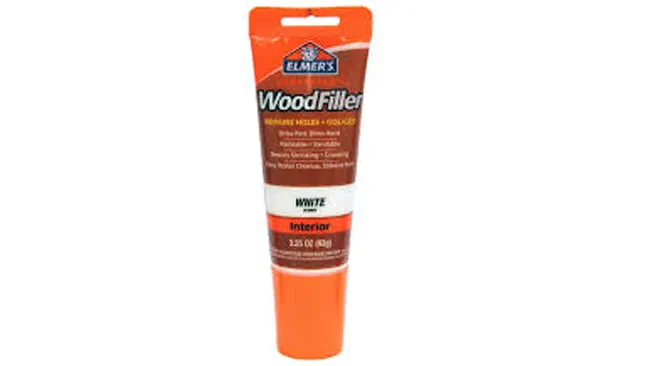
Technical Specification
- Color: White
- Weight: 3.25 Oz
- Liquid Volume: 3.25 Fluid Oz
- Form: Cream
Elmer’s Carpenter’s Wood Filler is perfect for quick touch-ups and fixes, offering a straightforward, no-mess application that’s ideal for a wide range of indoor woodwork. Its sandable and paintable qualities allow for a perfectly blended finish that’s both practical and visually appealing.
Advantages
- Indoor use
- Sandable and paintable
- Easy water clean-up
Disadvantages
- Not for exterior
- Limited flexibility
- Longer drying time
About this item
- Sands smoothly, facilitating flawless surface preparation for finishing work.
- Once dried, it can be painted to exactly match your woodwork, ensuring that repairs are undetectable.
- It’s specifically formulated for interior applications, ensuring reliable repairs on indoor projects.
- Additionally, this wood filler is easy to clean up with water, making post-repair cleanup simple.
2. Goodfilla Wood & Grain Filler – Eco-friendly versatility.
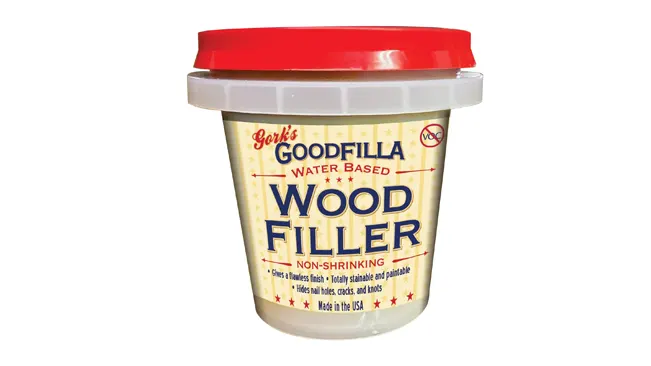
Technical Specification
- Weight: 8 Oz
- Material: Polymer
- Size: 1 Gallon
- Color: Neutral
Goodfilla Wood & Grain Filler is not only friendly to the environment but also provides a versatile filling solution that can be used on a variety of wood surfaces. Its ability to accept stains and finishes makes it a top choice for both DIY enthusiasts and professional woodworkers looking for an eco-conscious option.
Advantages
- Eco-friendly
- Stainable and paintable
- Versatile for many woods
Disadvantages
- Possible shrinkage
- May require multiple applications
- Not ideal for large repairs
About this item
- Stainable, allowing it to seamlessly blend with your woodwork for a natural finish.
- It’s an eco-friendly choice, made with sustainable practices in mind for the environmentally conscious user.
- This filler expertly fills wood grain, ensuring a smooth look and even texture upon application.
- Additionally, Goodfilla is versatile, suitable for both professional furniture makers and home DIY projects.
3. Minwax Stainable Wood Filler – Excellent stainability.
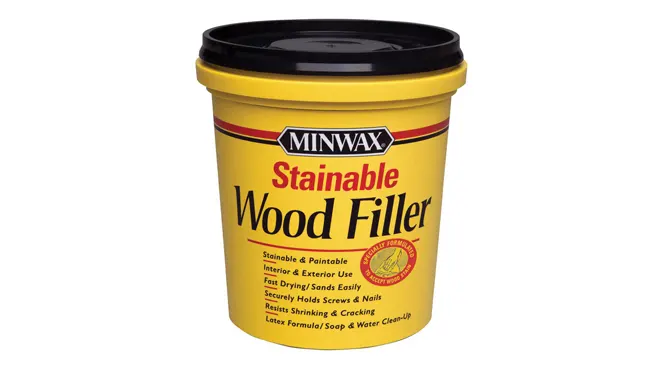
Ideal for repairing cracks, small gouges, nail holes knot holes.
Minwax Stainable Wood Filler is designed to be fully compatible with wood stains, blending seamlessly with the surrounding wood when colored. This characteristic ensures a professional and cohesive appearance for all wood repair projects, from
Advantages
- Good for staining
- Sandable after drying
- Works on hardwoods
Disadvantages
- Can be pricey
- Not for large holes
- Longer dry time
About this Item
- Specifically designed for staining projects, integrating well with wood stains for consistent color.
- It’s easily sandable, providing a smooth surface that’s essential for a finely finished woodworking project.
- Suitable for all wood types, Minwax is a go-to for both softwoods and hardwoods repair needs.
- This filler also has a quick-dry formula, allowing for faster project completion without long waits.
4. DAP All Purpose Wood Filler – Fast-drying versatility.
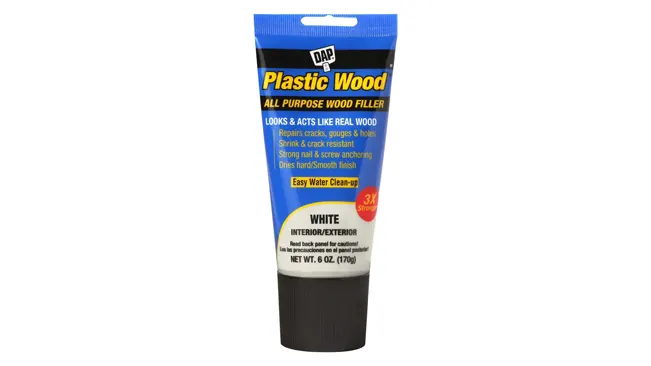
Crack & crumble resistant with strong nail & screw anchoring for easy wood repairs.
DAP All Purpose Wood Filler dries quickly, minimizing waiting time, and is a versatile filler that’s compatible with all types of paint. This makes it an ideal solution for projects requiring rapid progression from repair to finish, ensuring deadlines are met with efficiency.
Advantages
- Multipurpose application
- Quick drying
- Easy to sand
Disadvantages
- Not for heavy-duty
- Shrinkage possible
- Limited size options
About this Item
- Dries quickly, making it an excellent choice for making fast repairs without delay.
- It offers versatile sandable and paintable properties, adapting to various finishing processes.
- Applicable for both interior and exterior works, DAP is robust for any environment.
- The wood filler is also non-shrinking, maintaining the integrity of your repair over time.
5. Elmer’s E892 – Outdoor resilience.
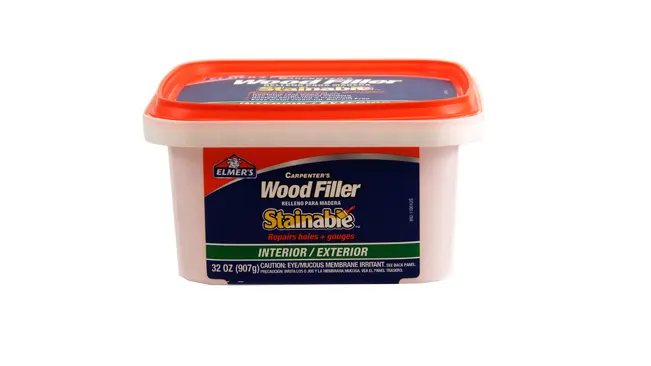
Contains real wood fibers for superior sanding, staining and painting, resists shrinking and cracking, firmly holds screws and nails.
Elmer’s E892 Wood Filler, specially formulated for outdoor use, offers excellent resistance to the elements, ensuring long-lasting wood repairs. Its strong adherence to wood surfaces means it can withstand various weather conditions, from intense sunlight to heavy rain, without shrinking or cracking.
Advantages
- Stainable for exterior
- Weather-resistant
- Paintable after use
Disadvantages
- Not for structural
- Longer cure time
- May discolor over time
About this Item
- Durable enough to withstand harsh outdoor conditions, from rain to sunlight.
- Paintable, allowing for aesthetic matching to existing wood structures and finishes.
- Its formulation resists shrinking and cracking, ensuring long-term stability and maintainability of the repair.
- Elmer’s E892 also adheres well to painted surfaces, making it versatile for various projects.
6. Ronseal High-Performance Wood Filler – Excellent for durability.
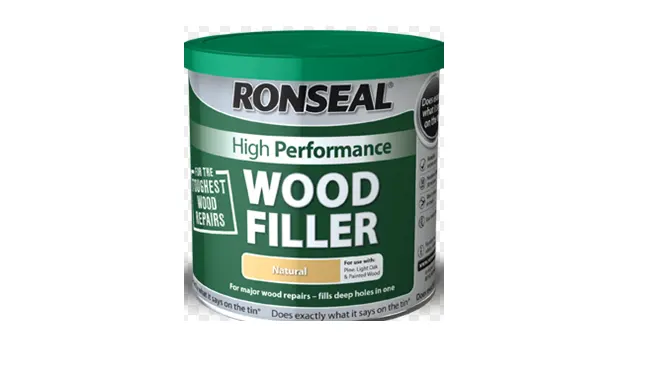
A high performance wood filler that lasts for years even when exposed to harsh weather conditions. It can fill to any depth and dries in just 30 minutes.
Ronseal High-Performance Wood Filler’s robust formula is designed to withstand heavy use, making it ideal for repairing areas subject to frequent wear and tear. Its strength and reliability ensure that once an area is repaired, it remains in pristine condition for years to come.
Advantages
- Very durable
- For interior and exterior
- Can drill, screw, sand
Disadvantages
- Higher cost
- Harder to apply
- Quick set time
About this Item
- Provides high strength, ensuring longevity and durability in the repairs it’s used for.
- Weatherproof qualities make it perfect for outdoor use, resisting the effects of weather exposure.
- It’s not only suitable for drilling and sanding but also for carving and planning after curing.
- Additionally, Ronseal is quick to harden, reducing the waiting time for finishing the work.
7. Bondo Wood Filler – Great for larger repairs.
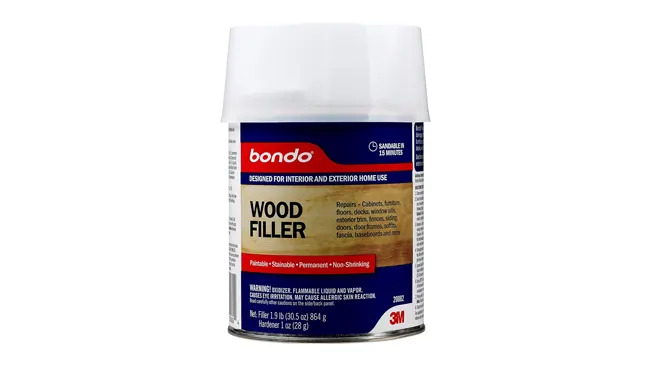
a permanent, fully paintable repair material for a broad range of projects inside and outside the home. Ideal for almost any wood surface, the two-part wood filler forms a permanent bond and will not shrink.
Bondo Wood Filler is adept at handling extensive wood damage, filling in large gaps and voids with a formula that’s easy to work with. Its thick consistency allows it to stay in place during the curing process, creating a strong bond that restores the integrity of the wood.
Advantages
- Fast curing time
- Sandable and paintable
- Good for large repairs
Disadvantages
- Strong odor
- Requires careful mixing
- Not flexible
About this Item
- Sets fast, which is perfect for projects where time is of the essence.
- It’s especially effective for large wood repairs, filling gaps and rebuilding missing pieces.
- Once it dries, it’s sandable to a fine finish, ready for painting or staining.
- This wood filler is also reinforced with wood fibers for added strength in repairs.
8. FamoWood 40022126 Latex Wood Filler – Easy to sand and paint.
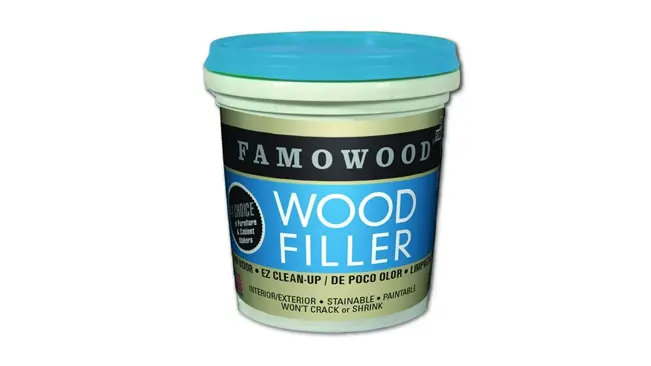
Spreads easily and requires very little sanding to achieve the desired finished look.
FamoWood’s Latex Wood Filler is particularly valued for its easy sanding property, which allows for a smooth, paint-ready finish. This makes it a favorite for fine woodworking where a polished surface is essential, giving both DIYers and professionals the ability to create a flawless end product.
Advantages
- Latex-based, easy clean
- Sandable once dry
- Accepts stains well
Disadvantages
- May not for outdoors
- Not for fine cracks
- Potential for shrinkage
About this Item
- Latex base makes cleanup easy and hassle-free, without the need for solvents.
- It sands to a flawless finish, ensuring any imperfections are easily smoothed out.
- Paintable for perfect color matching, FamoWood allows for a cohesive appearance in woodwork.
- It also boasts minimal shrinking, helping to maintain the filler’s shape and size over time.
9. Aqua Coat Wood Grain Filler – Best for grainy woods.
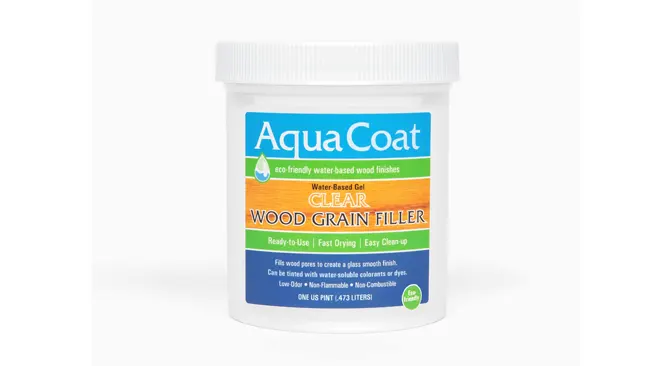
Penetrates and seals the pores minimizing the absorption of your topcoats, achieving a glass smooth, pristine, clear finish in less coats.
Aqua Coat Wood Grain Filler is the ideal choice for maintaining the natural look of wood, as it fills in grains without altering the wood’s inherent texture. It provides a smooth surface that’s ready for finishing touches, preserving the authenticity of wood’s appearance.
Advantages
- Clear gel finish
- Excellent for grainy woods
- Can be tinted
Disadvantages
- Longer drying time
- Learning curve for application
- Multiple coats needed
About this Item
- Clear formula keeps the natural look of wood while filling in grains.
- It fills pores to create even surfaces, perfect for tabletops or cabinetry that require a fine finish.
- This grain filler is sandable to perfection, allowing for superior refinishing and smoothing.
- Aqua Coat also dries transparent, making it ideal for maintaining the wood’s original hue.
10. Abatron WoodEpox Kit – Restorative Filler
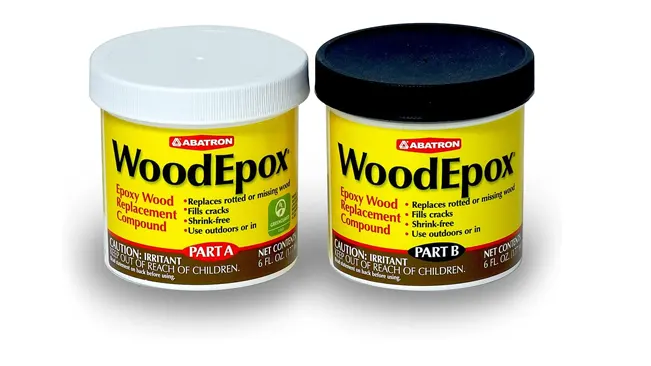
Technical Specification
- Type: Epoxy Wood Filler
- Components: Two-part system
- Workability: Moldable and Shapable
- Curing: Quick-set formula
The Abatron WoodEpox Kit stands out as the ultimate tool for wood restoration projects. Its two-part epoxy system is engineered to fill in and bond with wood fibers, creating a repair that is both strong and seamlessly integrated with the original wood. Its moldable consistency and quick curing time allow for rapid repairs that last.
Advantages
- Permanent, shrink-free repairs.
- Paintable and stainable once cured.
- Ideal for intricate wood restoration.
Disadvantages
- May require color matching for aesthetic consistency.
- Learning curve for first-time users.
About this Item
- Best suited for window sills, frames, and structural repairs.
- Fully curable for indoor and outdoor use.
- Compatible with professional woodworking tools for final shaping.
Abatron WoodEpox provides a professional-grade solution to bring damaged wood back to life, making it a favorite among preservationists and DIY enthusiasts alike.
Choosing the right Wood Filler
Choosing the right wood filler is pivotal for any woodworking project, as it ensures the integrity and aesthetics of the final product. The ideal wood filler should match the type of wood you’re working with and be suitable for the intended finish, whether that’s staining, painting, or varnishing.
In the second stage of selection, consider the filler’s drying time and whether it’s designed for indoor or outdoor use, as some are specifically formulated to withstand the elements. Also, factor in the ease of application and sandability, which can significantly affect the workflow and final appearance of your workpiece.
Type of Wood
Select a filler that matches the wood you’re working with, considering whether it’s hardwood or softwood.
Selecting the right wood filler often hinges on the type of wood you’re working with, as different woods have unique characteristics and absorb finishes differently. For instance, a filler that is compatible with the natural color and grain pattern of oak may not be suitable for pine, which requires a different texture and absorption rate for a seamless look.
Purpose of Use
Determine if the filler needs to be stainable, paintable, or both, to ensure it blends seamlessly with your project.
The purpose of use is a critical consideration when selecting the right wood filler; it’s essential to match the product to the task at hand. For instance, if the end goal is to paint over the repaired area, a paintable filler is needed, whereas projects that will be stained require a stainable filler to ensure a uniform finish.
Durability
If you’re working on an outdoor project, choose a filler that is formulated to be weather-resistant.
Durability is a key factor in choosing the right wood filler, especially for projects exposed to varying environmental conditions. Outdoor projects, for instance, require a wood filler that can withstand elements like moisture, temperature fluctuations, and UV exposure without deteriorating or losing its bonding strength.
Shrinkage and Cracking
Look for a filler that resists shrinking and cracking to avoid future repairs.
In selecting the right wood filler, paying attention to its tendencies for shrinkage and cracking is crucial. A quality filler should maintain its volume and integrity as it dries, ensuring that the repair remains seamless and durable over time, without the need for frequent touch-ups.
Drying and Curing Time
Consider the drying and curing time of the filler, especially if you’re working within a tight schedule.
The drying and curing time of wood filler is an essential aspect to consider, as it can significantly impact your project timeline. A quick-drying filler is ideal for fast-paced projects or when multiple layers are required, while longer curing fillers may offer a stronger bond suitable for heavy-duty or large-scale repairs.
Conclusion
selecting the best wood filler for your project is a decision that hinges on various factors including the type of wood, the intended purpose of use, durability requirements, resistance to shrinkage and cracking, and the drying and curing time. The right choice in wood filler ensures not only an aesthetically pleasing finish but also contributes to the longevity and structural integrity of your woodwork, making it a critical component in achieving superior wood repair solutions.
Frequently Asked Questions (FAQs)
- Is wood filler paintable?
Yes, most wood fillers are designed to be paintable for a seamless finish on repaired surfaces. - Can wood filler be sanded?
Yes, after drying, wood filler can be sanded smooth to match the surrounding wood surface. - Does wood filler work on all types of wood?
While versatile, it’s important to choose a filler compatible with the specific type of wood you’re repairing. - How long does wood filler take to dry?
Drying times vary; some dry within hours, while others might need a full day. - Can wood filler fix large cracks?
For small to medium cracks, wood filler is effective, but large gaps may require a different approach. - Is wood filler weather-resistant?
Some wood fillers are designed for outdoor use with weather-resistant properties. - Can wood filler be stained?
Stainable wood fillers are available, designed to absorb stains like natural wood. - Is wood filler as strong as wood?
While durable, filler isn’t meant to replace structural wood integrity. - Can you use wood filler on plywood?
Yes, wood filler can be used effectively on plywood for repairs. - Does wood filler shrink as it dries?
Quality wood fillers are formulated to minimize shrinking during the drying process.













Leave your comment